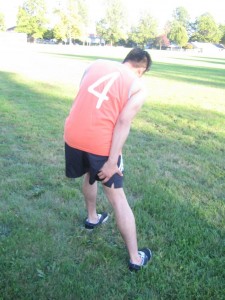It is important to note that posterolateral corner injuries typically cause pain at the rear area and exterior region of the knee. These are not considered as common injuries, but around half of the cases occur due to sporting injuries as well as during vehicular accidents.
What are the symptoms?
The indications of posterolateral corner injury tend to vary slightly depending on the grade of the injury. To learn to recognize and manage the symptoms of this injury, register for a first aid course today.
- Swelling and pain in the rear and exterior part of the knee
- Tenderness on the lateral knee usually over the head of the fibula
- Knee instability
- Hyperextension or over straightening of the knee
- Walking with the knee in a continuously bent position to avoid hyperextension

Take note that the symptoms are present in all grades and steadily become severe.
Close look on the posterolateral corner
The posterolateral corner is comprised of various structures that function to stabilize the knee joint against backward and external rotation forces on the knee.
Causes
The structures in this area are likely to end up injured due to the hyperextension force from the front and interior area of the knee joint. During sports injuries, these soft tissue structures are pulled away from their bony attachment points. The posterolateral corner injuries frequently develop along with other injuries to the knee, particularly to the posterior cruciate ligament, tibial plateau and anterior cruciate ligament.
Classification
The posterolateral corner injuries are divided into grade 1, 2 or 3 depending on the severity as well as the extent of the injury. The injuries are categorized based on the degree of gap in the joint once the doctor stresses manually the lateral joint as well as the end feeling when this movement is performed.
The grade 1 injuries involve a 3-5mm gap with a clear end point. As for grade 2 injuries, it involves a 5-10mm gap with a clear end point. The grade 3 injuries involve a gap that is more than 10mm along with a very soft or a non-existent end-feel.
Treatment
The management of a posterolateral corner injury usually depends on the severity of the injury as well as the timescale right after injury in which the injury is diagnosed.
Grade 1 and minor grade 2 injuries can be managed with conservative measures with good results. The knee must be initially stabilized using a hinged brace and controlled weight bearing for 2-4 weeks. Right after this, a rehabilitative program is started which involves the restoration of full knee motion as well as building strength on the quadriceps muscles.
In severe grade 2 and 3 injuries, they require surgical treatment. The acute injuries are often managed with repair while chronic ones entail surgical intervention. Remember that repair is not possible after the acute phase has passed due to the development of scar tissue as well as joint misalignment. In reconstructive procedures, a graft will be taken from the IT band, Achilles tendon, semitendinosus tendon, patella tendon or the posterior or anterior tibialis tendon in order to reinvent the structures that were ruptured.
